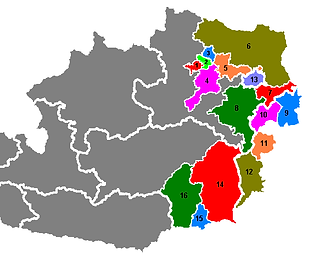Grape varieties:
As can be seen, Grüner Veltliner is the dominant white grape in Austria, producing generally dry wines ranging from short-lived Heuriger wines to Spätleses capable of long life.
The ancient Welschriesling variety is used in the noble rot dessert wines of the Neusiedlersee; it also makes undistinguished dry wines for drinking young, as does Müller-Thurgau (Rivaner).
Neuburger was supposedly found as flotsam in the Danube in the 1850s but is now known to be a clone between Silvaner and the ancient Roter Veltliner.
Frühroter Veltliner is also known as Malvasier, suggesting a link to the Malvasia grape family of the Eastern Mediterranean.
Muscat Ottonel is used in dessert wines from the Neusiedlersee, as is Bouvier, which is related to the Muscat family and is a parent of the Orémus (Zéta) grape used in Tokaji.
There were high hopes for Goldberger, a cross between Welschriesling and
Orangetraube bred in Klosterneuburg, but after an initial wave of planting, enthusiasm has dimmed.
Zierfandler (Spätrot) and Rotgipfler are local grapes of the Thermenregion and are often blended together as Spätrot-Rotgipfler.
It is worth noting that Pinot Gris is known as Ruländer in Austria, and sometimes as Grauburgunder; Pinot blanc is known as Weißburgunder or Weissburgunder, and Sauvignon blanc is called Muskat Sylvaner.
Riesling plays a much smaller role than in Germany, but the relatively small amount grown is used for some of Austria's most appreciated dry white wines.
Zweigelt sometimes called Zweigeltblau, a Blaufränkisch & St. Laurent cross and Blauburger (Blaufränkisch & BlauerPortugieser) were bred at Klosterneuburg in the 1920s and now account for nearly half of Austria's red wine.
The former can be made into powerful wines for ageing, the latter is easier to grow and is generally blended; both are also made into a lighter style for drinking young.
Blaufränkisch and Blauer Portugieser are the traditional red grapes of the region, being part of the blend of Hungary's Egri Bikavér.
The former is the more "serious" variety, Blauer Portugieser produces fresh, fruity red wines for drinking young.
Saint Laurent came from France in the mid-19th century, and seems to have substantial Pinot noir (Blauerburgunder) parentage; St Laurent has a reputation for being problematic to grow but can produce good quality wine.
Blauer Wildbacher is probably an indigenous wild grape variety, used to make a cult rosé called Schilcher in western Styria. Rössler is the latest variety to be bred at Klosterneuburg.

